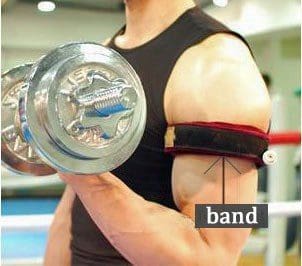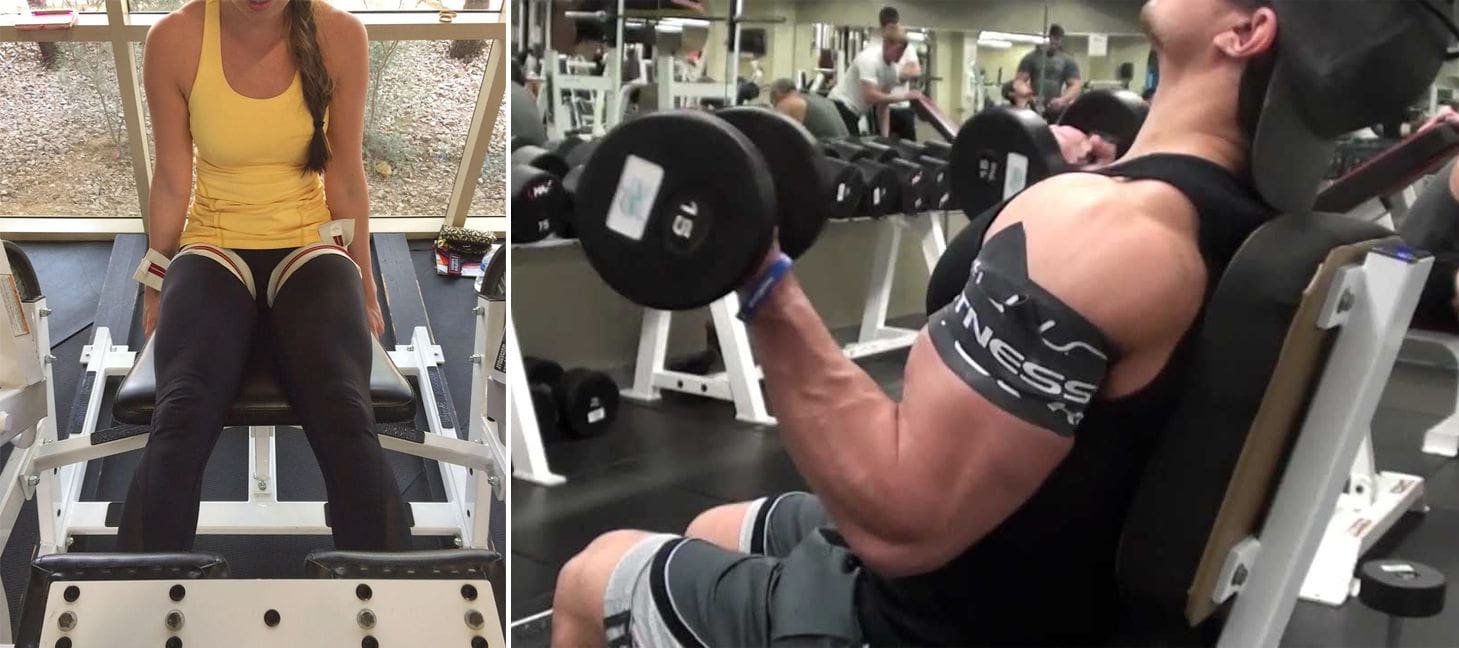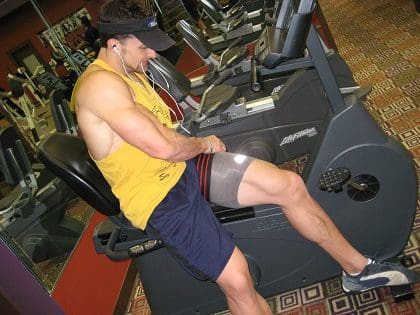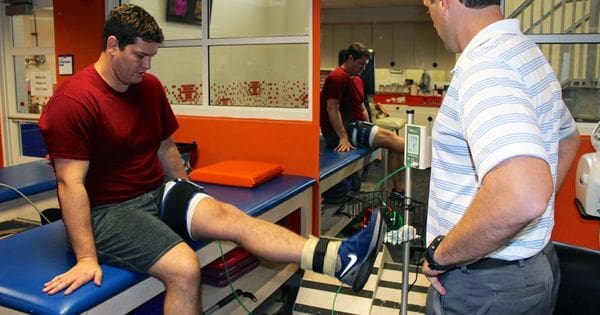Blood is responsible for the transportation of oxygen, nutrients, and other molecules crucial for life. Most bodybuilders may also tell you that blood is important for gaining muscle, blood flow to be more particular. A whole group of nutritional supplements has surfaced in the past ten years, concentrated on boosting anabolism and so increasing circulation.
However, what if I told you that the opposite could be true? If I told you that occluding blood flow to muscles could have an anabolic effect, what would you say? Blood flow restriction (BFR) training has years of research to support its effectiveness and in this article I will explain what it is and how to use it to augment your training.
Table of Contents
What is Blood Flow Restriction Training?
Quite simply, BFR training includes restricting the venous return of blood circulation from the muscle. The objective isn’t to restrict blood circulation to the muscle, but rather prevent blood flow from returning to the muscle, i.e. you don’t need to restrict the blood circulation to the muscle, only the venous return from the muscle, causing the blood to pool in the muscle. This is accomplished by use of a blood pressure cuff or perhaps more practically using knee wraps tightly fastened round the limb(s).



For instance, to utilize blood flow restriction therapy on arm muscles, you would tightly secure a cloth or barbell knee wraps close to the shoulder as possible. This will restrict blood flow return from the arms and cause the blood to pool.
Blood flow restriction training, when done correctly, allows one to utilize much lower weights than normal training protocols and still attain sizable anabolic training results. Actually, occlusion training can increase muscle size and strength using training heaps as mild as 20 percent of a 1 rep max. This is especially useful for trainers who are currently experiencing a deload phase in their training practice or for individuals that are hurt and can only use light weights. BFR training allows you to still make gains using light weights while giving your joints, ligaments, and tendon a rest from heavy lifting.
Blood Flow Restriction Training Effects
Blood flow restriction training induces an anabolic response through various pathways, perhaps the most crucial of which will be by preferentially targeting the big fast twitch muscle fibers. Fast twitch fibers are the muscle fibers that have the potential for growth. These fibers are recruited last during contractions and therefore are largely anaerobic (do not use oxygen) whereas the smaller slow twitch fibers are recruited first through contractions and are aerobic (use oxygen). Slow twitch fibers have a potential for growth compared to fast twitch fibers.
BFR training restricts blood flow to muscles, pre-fatiguing the slow twitch fibers and forcing the anaerobic fast twitch fibers to deal with the load even at low intensities. Metabolically, your muscle is getting an effect that is similar lifting heavy loads although they are using weights that are much lighter. Not only does occlusion training preferentially activate fast twitch muscle fibers, it has been shown to cause a fiber type shift from slow to fast, thus increasing the possibility of muscle growth dimensions.
Metabolic by-product accumulation is primary mechanism by which occlusion training produces hypertrophy. These metabolic by-products would normally be ‘washed out’ by normal blood flow, but occlusion allows them to accumulate near the muscle. Lactate accumulation in particular seems to have an effect, presumably by raising growth hormone (GH) concentrations (4-5). In fact, one study found that BFR training triggered a GH increase 290 times above baseline. This really is a twofold greater increase in GH than what is generated by regular heavy resistance training.
Perhaps even more impressive, blood flow restriction training was demonstrated to reduce myostatin concentrations. Myostatin is a time inhibitor of muscle growth and is thought to limit the possibility of muscle gain. Occlusion training could be able to increase the potential of muscle increase through slow to quickly fiber shifts and reductions in myostatin.

As always, before starting any type of training routine, you should talk with a medical professional. BFR can be performed for the thighs, calves, upper arms, and forearms with a blood pressure cuff or tightly wrapped knee bends (more practical). To occlude the thighs and upper arms, wrap at approximately 70 percent of greatest tightness around the part of their muscles. To occlude forearms wrap or the calves at approximately 70 percent of maximum tightness below the knee or elbow.
Perform 3-5 sets to muscular failure with 20-50 percent of your 1 rep maximum on a particular exercise together with the muscle occluded the whole time. Periods should be 30-60 seconds between sets. After the last set restore blood flow to the muscle and then remove the wraps. Blood flow restriction training takes training to another dimension.
The scope of our information is limited to chiropractic and spinal injuries and conditions. To discuss options on the subject matter, please feel free to ask Dr. Jimenez or contact us at 915-850-0900 . 
By Dr. Alex Jimenez
Additional Topics: Sports Care
Athletes engage in a series of stretches and exercises on a daily basis in order to prevent damage or injury from their specific sports or physical activities as well as to promote and maintain strength, mobility and flexibility. However, when injuries or conditions occur as a result of an accident or due to repetitive degeneration, getting the proper care and treatment can change an athlete’s ability to return to play as soon as possible and restore their original health.
<
div class=”video-container”>
<
iframe src=”https://www.waxwinginteractive.com/manage/admin/playembed.php?vid=13&client=1350 scrolling=”no” border-width=”0″>

TRENDING TOPIC: EXTRA EXTRA: New PUSH 24/7Â®ï¸ Fitness Center
Post Disclaimer
Professional Scope of Practice *
The information herein on "Blood Flow Restriction Training Overview | BFR Specialist" is not intended to replace a one-on-one relationship with a qualified health care professional or licensed physician and is not medical advice. We encourage you to make healthcare decisions based on your research and partnership with a qualified healthcare professional.
Blog Information & Scope Discussions
Welcome to El Paso's Premier Wellness, Personal Injury Care Clinic & Wellness Blog, where Dr. Alex Jimenez, DC, FNP-C, a Multi-State board-certified Family Practice Nurse Practitioner (FNP-BC) and Chiropractor (DC), presents insights on how our multidisciplinary team is dedicated to holistic healing and personalized care. Our practice aligns with evidence-based treatment protocols inspired by integrative medicine principles, similar to those found on this site and our family practice-based chiromed.com site, focusing on restoring health naturally for patients of all ages.
Our areas of multidisciplinary practice include Wellness & Nutrition, Chronic Pain, Personal Injury, Auto Accident Care, Work Injuries, Back Injury, Low Back Pain, Neck Pain, Migraine Headaches, Sports Injuries, Severe Sciatica, Scoliosis, Complex Herniated Discs, Fibromyalgia, Chronic Pain, Complex Injuries, Stress Management, Functional Medicine Treatments, and in-scope care protocols.
Our information scope is multidisciplinary, focusing on musculoskeletal and physical medicine, wellness, contributing etiological viscerosomatic disturbances within clinical presentations, associated somato-visceral reflex clinical dynamics, subluxation complexes, sensitive health issues, and functional medicine articles, topics, and discussions.
We provide and present clinical collaboration with specialists from various disciplines. Each specialist is governed by their professional scope of practice and their jurisdiction of licensure. We use functional health & wellness protocols to treat and support care for musculoskeletal injuries or disorders.
Our videos, posts, topics, and insights address clinical matters and issues that are directly or indirectly related to our clinical scope of practice.
Our office has made a reasonable effort to provide supportive citations and has identified relevant research studies that support our posts. We provide copies of supporting research studies upon request to regulatory boards and the public.
We understand that we cover matters that require an additional explanation of how they may assist in a particular care plan or treatment protocol; therefore, to discuss the subject matter above further, please feel free to ask Dr. Alex Jimenez, DC, APRN, FNP-BC, or contact us at 915-850-0900.
We are here to help you and your family.
Blessings
Dr. Alex Jimenez DC, MSACP, APRN, FNP-BC*, CCST, IFMCP, CFMP, ATN
email: coach@elpasofunctionalmedicine.com
Multidisciplinary Licensing & Board Certifications:
Licensed as a Doctor of Chiropractic (DC) in Texas & New Mexico*
Texas DC License #: TX5807, Verified: TX5807
New Mexico DC License #: NM-DC2182, Verified: NM-DC2182
Multi-State Advanced Practice Registered Nurse (APRN*) in Texas & Multi-States
Multistate Compact APRN License by Endorsement (42 States)
Texas APRN License #: 1191402, Verified: 1191402 *
Florida APRN License #: 11043890, Verified: APRN11043890 *
License Verification Link: Nursys License Verifier
* Prescriptive Authority Authorized
ANCC FNP-BC: Board Certified Nurse Practitioner*
Compact Status: Multi-State License: Authorized to Practice in 40 States*
Graduate with Honors: ICHS: MSN-FNP (Family Nurse Practitioner Program)
Degree Granted. Master's in Family Practice MSN Diploma (Cum Laude)
Dr. Alex Jimenez, DC, APRN, FNP-BC*, CFMP, IFMCP, ATN, CCST
My Digital Business Card
RN: Registered Nurse
APRNP: Advanced Practice Registered Nurse
FNP: Family Practice Specialization
DC: Doctor of Chiropractic
CFMP: Certified Functional Medicine Provider
MSN-FNP: Master of Science in Family Practice Medicine
MSACP: Master of Science in Advanced Clinical Practice
IFMCP: Institute of Functional Medicine
CCST: Certified Chiropractic Spinal Trauma
ATN: Advanced Translational Neutrogenomics





 Again, We Welcome You.
Again, We Welcome You.
Comments are closed.